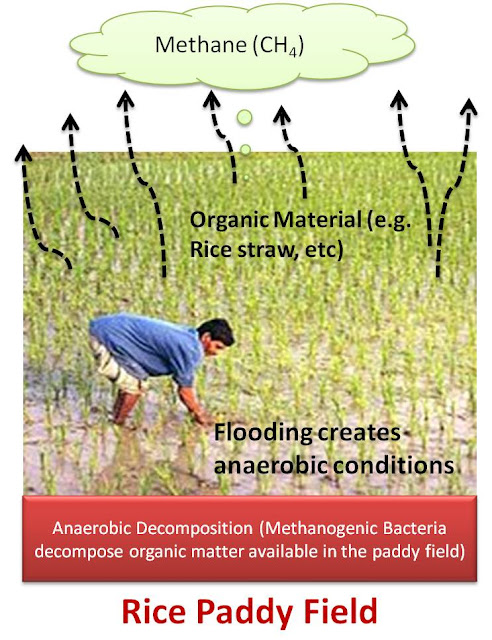...On average, (click here) the rice paddy soil is only fully waterlogged for about 4 months each year. For the rest of the time methanogenesis is generally much reduced and, where the soil dries out sufficiently, rice paddy soil can become a temporary sink for atmospheric methane....
...there is the great potential for improved varieties of rice, able to produce a much larger crop per area of rice paddy and so allow for a cut in the area of rice paddies, without a cut in rice production. Finally, the addition of compounds such as ammonium sulphate, which favour activity of other microbial groups over that of the methanogens, has proved successful under some conditions.
 There is what is coined by the USDA as an amendment to the soil for rice paddies, called "Biochar." The stuff works. (click here) But, the production of Biochar is just about as polluting as the rice fields. Its process takes 'biomass' and creates charcoal and by-products. The charcoal substance is considered the "Biochar" product that is stated to last thousands of years in the soil. Now, call me crazy, but, any product that stays in the soil for thousands of years doesn't sound like a good product to me.
There is what is coined by the USDA as an amendment to the soil for rice paddies, called "Biochar." The stuff works. (click here) But, the production of Biochar is just about as polluting as the rice fields. Its process takes 'biomass' and creates charcoal and by-products. The charcoal substance is considered the "Biochar" product that is stated to last thousands of years in the soil. Now, call me crazy, but, any product that stays in the soil for thousands of years doesn't sound like a good product to me.Besides the charcoal it produces another by-product is a bio-oil. ???? I think it can be used in replacement of oil for burning for heat. It is sometimes called "biocrude." Get the picture?
 The other by-product is 'syngas.' It is burning to the right in that picture. It doesn't burn blue like methane, but, it still releases CO2. Syngas is known to the petroleum industry and contains as much as one third hydrogen (which burns orange), 15 percent CO2, 42 percent CO, 1.5 percent methane, 18 percent Hydrogen Sulfide, ppmv, 36 percent Carbonyl Sulfide, ppmv and heat into the air.
The other by-product is 'syngas.' It is burning to the right in that picture. It doesn't burn blue like methane, but, it still releases CO2. Syngas is known to the petroleum industry and contains as much as one third hydrogen (which burns orange), 15 percent CO2, 42 percent CO, 1.5 percent methane, 18 percent Hydrogen Sulfide, ppmv, 36 percent Carbonyl Sulfide, ppmv and heat into the air.There needs to be an answer to the methane emissions from rice paddies, but, let it be from processes that are developed with the environment and soil in mind.
California Rice (click here)
Nowhere in the world is rice production more advanced than in California. Careful attention to every step in the cropping cycle and milling ensures that rice produced in our warm Mediterranean climate meets-and often exceeds-customers' expectations for great rice.
Field Preparation
In March, farmers begin to prepare their fields for planting. First, fields are carefully leveled with precision, GPS or laser-guided grading equipment. Level fields allow rice farmers to conserve water. Fertilizer is then added, and shallow furrows are rolled into the field. By April, the fields are ready to be planted....












